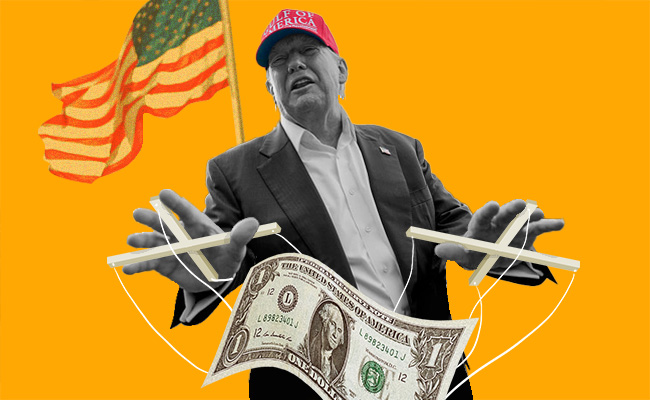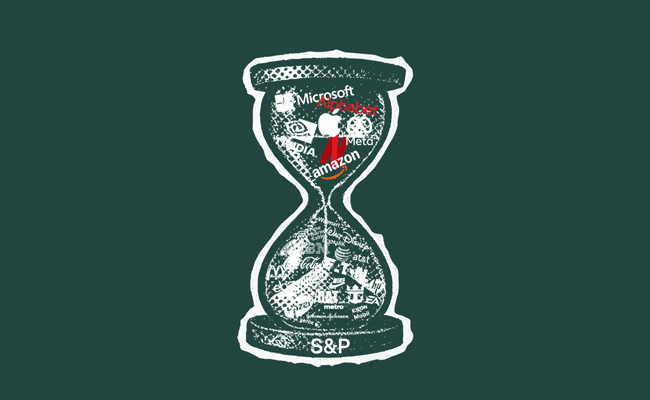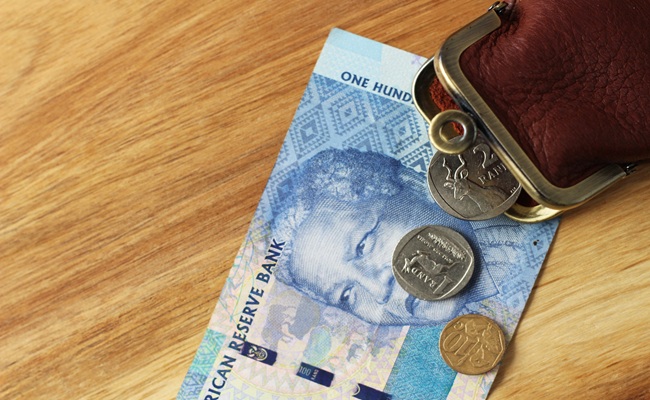“The [Donald] Trump shock, if it materialises, will not just be political. It could be the catalyst that ends the dollar’s remarkable run,” says Sahil Mahtani, head of macro research at Ninety One.
Mahtani’s paper, “The unstoppable dollar meets the immovable Mr Trump” argues that the structural forces that have kept the dollar atop its perch these past 14 years are now aligning “for a decisive reversal”.
“Full dollar cycles – lasting around 18 years – are rare, deeply entrenched, and only reverse when multiple macroeconomic and policy levers shift simultaneously. With a second Trump presidency now in play, all four of these levers – fiscal and current account deficits, interest rate differentials, global investment flows, and geopolitical alignment – are flashing red,” it says.
It’s a fascinating dive into the long-term cycles of the mighty US dollar, drawing on 50 years of data, which you can access here.
But what does a titanic turn in world currency markets mean for ordinary investors? And how does the average reader square off a bear market in the US currency with the relentless dominance of US equity markets, notwithstanding all the madness that has accompanied Trump’s economic policy calls this year?
“First, the US equity market is strong but year to date it’s been really trounced by the European equity market and a bunch of other non-US assets – and certainly in euros or emerging market (EM) currencies or yen,” Mahtani tells Currency in an interview.
“You start to do the numbers and it’s painful if you have an unhedged exposure,” he says. “So if you’re the allocator and you thought you were going to get two or three percentage points outperformance on your US assets and two or three percentage points on your currency, you are now in a world of pain.”
The dollar’s index’s 10% slide this year has also reignited debate that it may lose its role as the world’s principal medium of exchange. Or, as Mahtani puts it: “That’s because the world is becoming more multipolar, but seemingly the [US dollar] is steadily unipolar, so that’s the endless source of fascination.”
He argues it’s best to just “park” that view for the time being. What is important though is a cyclical dollar bear market. “We’ve had three cycles since 1970, and it’s the cyclical dollar bear market that investors can and should prepare for.”
That includes hedging your US dollar exposure – though that seems complicated for the average investor like you or me.
Asked about this, Mahtani says: “A lot of the time if you have equities, you won’t hedge them. A lot of fixed-income exposure is more hedged, so if you’re a lay investor you just increase your exposure to non-US assets.”
If, on the other hand, you’re a big money manager, and you do want to take underlying US equity and fixed income risk, in the past you’d have hedged more than you may have done recently. Mahtani’s suggestion for these investors is to just increase their hedge ratios to where they were a couple of years ago.
As Mahtani points out, there’ve been a lot of predictions about a dollar bear market since 2017, which haven’t played out. “If you looked at the data, the market was short dollars in 2017 and 2018 and 2021, and in those periods the four factors were not aligned.”
And while the dollar is down about 10% year to date, it’s actually only 4% weaker since the US elections in November 2024, he says. Which means that while there is now rising talk of the beginning of a dollar bear market, it’s not yet a widely held view.
“I don’t want people to think this is a consensus view because I don’t think a 4% fall from the election is a sign that the dollar bear market is baked in,” he says.
If Trump is the immovable object against which dollar strength finally runs aground, it’s fair to say he isn’t exactly likely to be a perennial fixture given the length of his (last) presidential term. Yet it’s his role as a catalyst for change that analysts like Mahtani are monitoring.
“If you get Trump putting enough force on the dollar cycle to shift the inertia, even once he’s gone the inertia keeps going. Which is why these dollar cycles are super long.”
So if the dollar enters a protracted bear market, what, or who, benefits?
“It depends on where investors see the nearest growth story,” says Mahtani. “At the moment the clearest growth story is Europe. [It] has gone from deindustrialisation, high energy prices, Ukraine war and political paralysis to massive German spending, co-ordinated industrial policy, massive amounts of private sector investment in defence so the story has shifted,” he argues.
Then there are emerging markets. “EMs, when they turn, they really turn.” Ninety One has a chart showing how, in the first year of a dollar bear market, there’s “massive” outperformance in EM fixed income and equities. “If we are in this cycle, and this is the first year of a big dollar bear market, then you just close your eyes and you buy.”
Picking companies before currencies
Rob Oellermann, who heads up Laurium’s offshore-based global equity funds, concurs that emerging markets and commodities should benefit if the dollar’s in for a tough time. But he takes the view that investors should concentrate on companies, not currencies.
“We pick companies before we pick currencies. What’s most meaningful for us is the underlying company performance or management teams and product sets. Currency moves of 10% or 15% are violent if they happen over short periods of time, but the best companies more or less ride through those over the longer term,” he says.
And then there’s the fact that a lot has happened to the dollar in a short space of time this year already. Oellermann, as it turns out, is of the view that a dollar bear market may already be priced in; “it’s fair to say that it’s become a bit of a consensus view, and consensus views are generally not that lucrative,” he says.
There is one caveat though: who Trump appoints as the next head of the US Federal Reserve. He has been virulently anti the present central bank chief Jerome Powell, who he calls “Too Late” for keeping interest rates high. Or higher (4.25%) than where he’d like them (1%).
“Should Trump replace Powell between now and May with a cooing dove, I suspect that the dollar is still in for a rocky period. Because under the circumstances of a Fed being too soft on rates and not paying diligent enough attention to the long end of the yield curve, I think the ongoing move away from dollar assets continues,” says Oellermann.
However: “Playing devil’s advocate, you’re Donald Trump – do you want to sit with a currency crisis in the dollar? I don’t think so.”
As for Sasfin’s head of global equities, David Shapiro, he’s truly sceptical that a dollar bear market will – or should – make any real difference.
“My logic at the moment is: where would you rather invest? China, the UK, Europe, Japan or the US? Where do you want to put your money for growth? The US stands above these countries by a long shot. Why does AstraZeneca want to list there? Because that’s where things happen. Have a look at the top 10 corporates in the US now and there’s nothing to touch them.”
Fair enough: the world’s biggest companies – like Nvidia, Microsoft, Alphabet and Amazon are American. “And if you keep going down the supply chain or to businesses feeding them, they are mostly American too – with the exception of ASML, say. Structurally, no-one can touch the US,” argues Shapiro.
Which should concentrate investors’ minds on the reason you buy anything at all: because you expect to make money from it. Says Shapiro: “In other words: the reasons why a good company is a good company. And when you do that exercise – and I do it every day – the companies that stand out are American companies because of the pressure of surviving in America. You’ve got to be good.”
Top image: Donald Trump (Anna Moneymaker/Getty Images); Rawpixel/Currency collage.
Sign up to Currency’s weekly newsletters to receive your own bulletin of weekday news and weekend treats. Register here.











